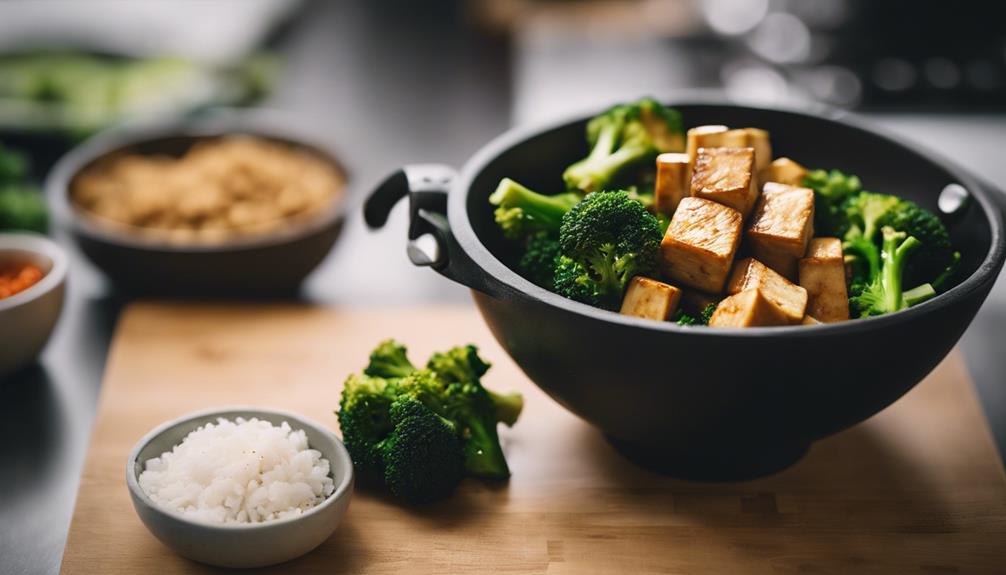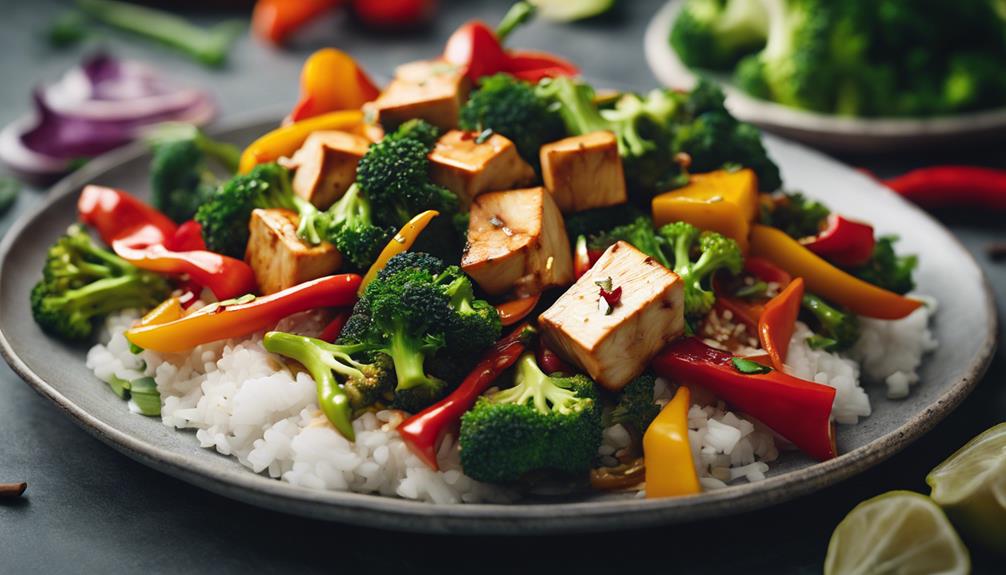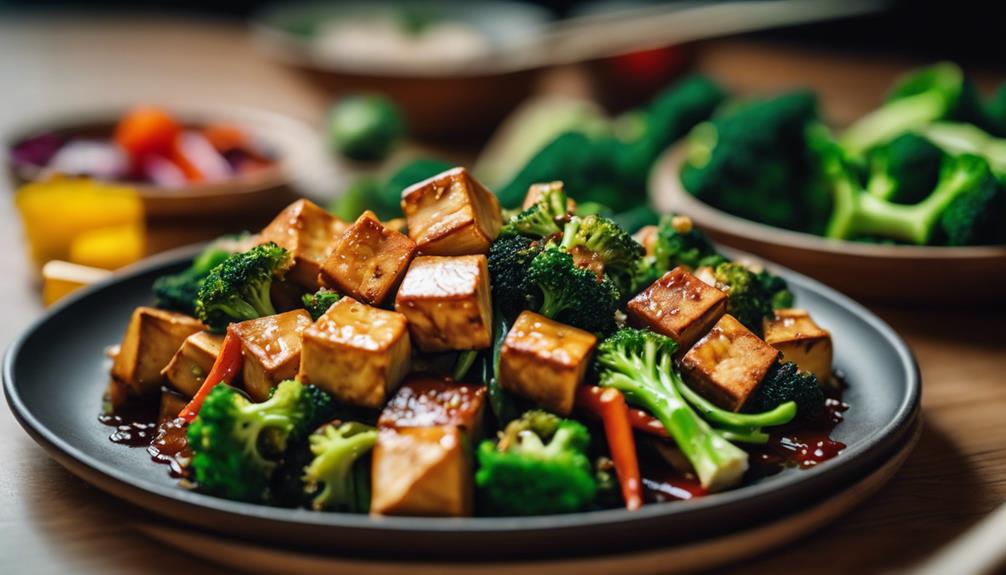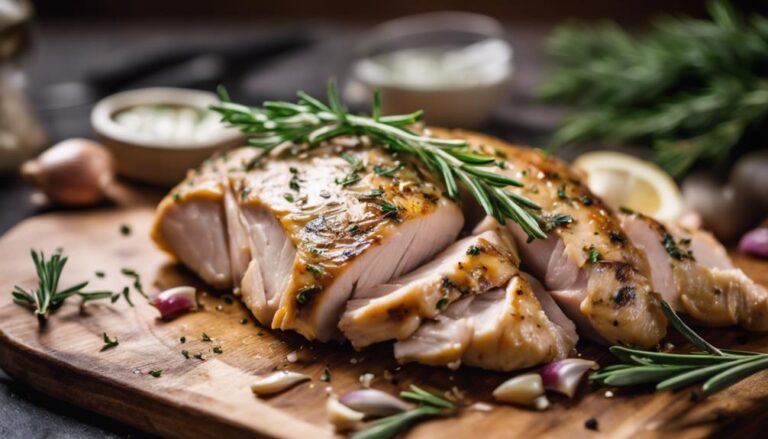Sous Vide Tofu and Broccoli Stir-fry
To make sous vide tofu and broccoli stir-fry, first, season tofu with soy sauce and spices, then vacuum-seal and sous vide at 165°F for 1 hour. Next, stir-fry broccoli, garlic, and ginger in a hot pan. Add the sous vide tofu and sauté briefly. Finally, blend in soy sauce and a hint of sweetness. The sous vide method retains tofu's moisture and brings out its flavors, while the stir-frying adds a crisp texture. Experiment with different marinades and sauces for unique tastes. Embrace this fusion dish for a delightful culinary experience with a balanced mix of textures and flavors.
What You Will Learn Here
- Sous vide tofu ensures a tender texture and flavor infusion.
- Broccoli maintains its vibrant color and nutrients when sous vide.
- Precook tofu and broccoli separately before stir-frying.
- Stir-fry briefly for a crispy texture and to retain flavors.
- Combine sous vide tofu and broccoli with stir-fried ingredients for a balanced dish.
Tofu's Asian Origins

Tofu has a rich history in Asian cuisine, where it plays a significant role in various culinary traditions.
In Chinese cooking, tofu is a versatile ingredient used in a wide array of dishes, from stir-fries to soups.
Japanese cuisine features tofu in delicate preparations like agedashi tofu, while Korean recipes showcase fermented tofu like dubu kimchi.
Tofu in Chinese Cuisine
Originating in Asia, tofu has been a staple ingredient in Chinese cuisine for centuries. Tofu, also known as bean curd, is made by coagulating soy milk and then pressing the resulting curds into soft white blocks. In Chinese cooking, tofu is prepared in various ways, such as steaming, boiling, or frying, to create a wide range of dishes with different textures and flavors.
Tofu preparation in Chinese cuisine often involves cutting the tofu into cubes, slices, or strips before incorporating it into stir-fries, soups, and braised dishes. Marinating tofu is a common practice in Chinese cooking to infuse it with flavors like soy sauce, ginger, garlic, and Chinese five-spice powder. Marinating helps the tofu absorb the seasonings, enhancing its taste and making it more flavorful in the final dish.
In Chinese cuisine, tofu is celebrated for its versatility and ability to absorb the flavors of the ingredients it's cooked with, making it a beloved ingredient in both vegetarian and meat-based dishes.
Tofu in Japanese Dishes
After delving into tofu's significance in Chinese cuisine, it's fascinating to observe its influence on Japanese dishes, where tofu plays a prominent role in various traditional recipes. In Japanese cuisine, tofu is valued not only for its versatility but also for its distinct texture. The Japanese have mastered the art of creating tofu with a silky, smooth texture that enhances the overall dining experience. This unique tofu texture is achieved through precise techniques passed down through generations.
One of the key elements that contribute to the delicious flavors in Japanese tofu dishes is the tofu marinades. These marinades are carefully crafted using a combination of soy sauce, mirin, dashi, and other ingredients that infuse the tofu with savory, umami-rich flavors. The tofu is often left to marinate for an extended period, allowing it to absorb the marinade fully and develop a depth of taste that complements the dish perfectly. In Japanese cuisine, tofu marinades are essential for creating dishes that are both flavorful and satisfying.
Tofu in Korean Recipes
In Korean culinary traditions, the incorporation of tofu showcases a harmonious blend of flavors and textures that elevate the overall dining experience. Korean marinades, known for their bold and savory profiles, often feature tofu as a key ingredient. Tofu in Korean recipes is prized for its ability to absorb these complex flavors while maintaining a delicate yet satisfying texture.
Korean cuisine expertly balances the soft, creamy texture of tofu with the robust umami notes of marinades made from ingredients like soy sauce, sesame oil, garlic, and ginger. The result is a dish that isn't only nutritious but also bursting with layers of taste.
Whether grilled, stir-fried, or simmered in a stew, tofu in Korean cooking offers a versatile canvas for the intricate flavors of traditional Korean seasonings. The subtle sweetness of tofu complements the spicy and tangy elements of Korean cuisine, creating a delightful harmony on the palate. Experimenting with tofu in Korean recipes allows you to explore the rich tapestry of Korean flavors while enjoying a healthy and satisfying meal.
Key Stir-fry Elements
To create a flavorful and well-balanced stir-fry dish, mastering the key stir-fry elements is essential. When preparing a stir-fry, pay attention to the following important components:
- Flavor infusion: Infusing your stir-fry with delicious flavors is a must. Utilize ingredients like garlic, ginger, soy sauce, and sesame oil to enhance the taste profile of your dish.
- Cooking techniques: Stir-frying involves quick cooking over high heat, making sure that your ingredients retain their crispness and vibrant colors. Mastering techniques like tossing the ingredients constantly and controlling the heat level is crucial for a successful stir-fry.
- Ingredient preparation: Properly preparing your ingredients by cutting them uniformly ensures even cooking and a visually appealing dish.
- Balancing flavors: Achieving a harmonious balance of salty, sweet, sour, and spicy flavors is key to a well-rounded stir-fry. Experiment with different combinations to find the perfect balance that suits your palate.
Stir-fry Recipe Variations

When exploring stir-fry recipe variations, you can try dishes like:
- Tofu and Mushroom Stir-fry
- Miso-Glazed Tofu Stir-fry
- Szechuan Tofu Stir-fry
These variations offer exciting flavors and textures to spice up your stir-fry routine.
Experimenting with different ingredients can lead to delightful discoveries in your culinary adventures.
Tofu and Mushroom Stir-fry
For an exciting twist on traditional stir-fry, consider incorporating tofu and mushrooms into your dish. When preparing a tofu and mushroom stir-fry, you can play with textures and flavors to create a delicious and nutritious meal. Here are some helpful tips to enhance your stir-fry:
- Tofu Texture: Experiment with different tofu textures such as silken, soft, firm, or extra firm to find the one that suits your preferences. Each type offers a unique mouthfeel and can impact the overall dish's consistency.
- Mushroom Pairing: Pair your tofu with a variety of mushrooms like shiitake, cremini, or oyster mushrooms for added depth of flavor. Mushrooms bring an earthy richness to the stir-fry and complement the tofu beautifully.
- Seasoning: Use a combination of soy sauce, garlic, ginger, and a touch of sesame oil for a savory umami-packed flavor profile.
- Vegetable Medley: Enhance your stir-fry with a colorful mix of vegetables like bell peppers, snap peas, and carrots to add freshness and crunch to the dish.
Miso-Glazed Tofu Stir-fry
Consider enhancing your tofu stir-fry experience by trying out a flavorful Miso-Glazed Tofu variation. When preparing this dish, the key lies in the miso marination and achieving the perfect tofu texture. Here are some tips to elevate your Miso-Glazed Tofu Stir-fry:
- Miso Marination: Marinate your tofu in a mixture of miso paste, soy sauce, and a touch of maple syrup for a harmonious blend of savory and sweet flavors.
- Tofu Texture: To achieve a delightful texture, press your tofu before marinating to remove excess moisture, allowing it to absorb the flavors better and develop a firmer texture.
- Flavor Infusion: Let the marinated tofu sit for at least 30 minutes or longer in the refrigerator to allow the flavors to penetrate the tofu fully.
- Cooking Technique: When stir-frying, make sure the pan is hot before adding the tofu to attain a crispy exterior while keeping the inside tender and flavorful.
Szechuan Tofu Stir-fry
To enhance your tofu stir-fry experience, try incorporating the bold flavors of Szechuan cuisine into your cooking with a spicy and aromatic Szechuan Tofu Stir-fry. Szechuan tofu is known for its spicy flavors that pack a punch and leave your taste buds tingling with delight. Here's how you can make a delicious Szechuan Tofu Stir-fry:
- Marinate cubed tofu in a mixture of soy sauce, Szechuan peppercorns, and chili paste for at least 30 minutes.
- Stir-fry the marinated tofu with garlic, ginger, and a medley of colorful bell peppers until the tofu is golden and the vegetables are tender-crisp.
- Add a savory sauce made from soy sauce, rice vinegar, and a touch of honey to coat the tofu and veggies with a delectable glaze.
- Garnish your Szechuan Tofu Stir-fry with sliced green onions and toasted sesame seeds for an extra burst of flavor and texture.
This bold and spicy Szechuan Tofu Stir-fry is sure to become a favorite in your stir-fry rotation, offering a delightful twist on traditional tofu dishes.
Stir-Frying Without Burning Tofu
To prevent tofu from burning while stir-frying, make sure you control the heat properly.
Quick flipping techniques can help evenly cook the tofu without scorching it.
Tofu Browning Prevention
To improve the browning of tofu while stir-frying, adjust the cooking temperature and utilize proper stirring techniques. When stir-frying tofu, achieving the right texture without burning it can be a delicate balance. To maintain the tofu's light color and soft texture, start by ensuring your pan is heated to a medium-high temperature. Adding the tofu to a hot pan helps to sear the outside quickly, preventing excessive browning. For best results, use a non-stick pan or a well-seasoned cast-iron skillet to prevent sticking and uneven browning.
Incorporating some browning tips can also help. Gently patting the tofu dry before cooking removes excess moisture, allowing it to brown evenly without sticking. Another useful tip is to add a small amount of oil to the pan before cooking the tofu; this helps create a crispy exterior while maintaining a tender interior. By adjusting the heat and employing proper stirring techniques, you can achieve perfectly cooked tofu in your stir-fry without any unwanted browning.
Proper Heat Control
Maintain control over the heat when stir-frying tofu to prevent burning and achieve best results. Proper heat management is essential in stir-frying to guarantee the tofu cooks evenly without scorching.
Start by preheating your pan over medium heat and adding oil just before adding the tofu. Adjust the heat as needed to maintain a gentle sizzle without smoking the oil. Stir frequently to distribute the heat evenly and prevent hot spots that can lead to burning.
Balancing the heat will help you achieve the desired texture and flavor. Remember that tofu absorbs flavors well, so maintaining the right heat level allows it to caramelize and develop a deliciously crispy exterior while remaining tender inside.
This process not only prevents burning but also enhances the overall taste of the dish. By mastering heat control during stir-frying, you can create a perfectly cooked tofu and broccoli stir-fry with a harmonious flavor balance that will impress your taste buds.
Quick Flipping Technique
When stir-frying tofu to avoid burning, master the quick flipping technique for even cooking and a perfect texture. To prevent your tofu from sticking to the pan and make certain that it cooks evenly, use a spatula to quickly flip the tofu cubes or slices during the stir-frying process. This flipping technique helps distribute the heat more evenly, preventing any one side from getting too hot and burning the tofu.
For successful stir-frying without burning your tofu, it's essential to maintain a moderate to high heat level throughout the cooking process. Keep the tofu moving in the pan by flipping it frequently, making sure that all sides are cooked to perfection. Additionally, incorporating the broccoli into the stir-fry at the right moment will help balance the cooking time between the tofu and vegetables.
Remember these cooking tips and practice the quick flipping technique to achieve a delicious and well-cooked tofu and broccoli stir-fry that's sure to impress your taste buds.
Final Thoughts

Consider incorporating a variety of colorful vegetables to enhance both the visual appeal and nutritional value of your Sous Vide Tofu and Broccoli Stir-fry. Reflections on your cooking journey may lead you to experiment with different flavor combinations to suit your palate. When preparing this dish, think about adding bell peppers, carrots, or cherry tomatoes to introduce a pop of color and a mix of textures. These additions not only elevate the appearance of your stir-fry but also contribute essential vitamins and minerals to your meal.
Exploring diverse flavor combinations can take your Sous Vide Tofu and Broccoli Stir-fry to the next level. Try incorporating ingredients like soy sauce, ginger, garlic, or a sprinkle of sesame seeds to impart depth and richness to the dish. Don't be afraid to get creative and tailor the seasonings to match your preferences. By playing around with different herbs and spices, you can craft a personalized flavor profile that makes each bite exciting. Remember, cooking is a journey, so have fun experimenting and discovering what works best for you.
Frequently Asked Questions
Can I Use Frozen Tofu for This Stir-Fry Recipe?
Yes, you can use frozen tofu for the stir-fry. Freezing tofu can alter its texture, making it chewier and more porous, which can help it absorb flavors better. Drawbacks include a slightly denser consistency compared to fresh tofu.
How Long Can I Store Leftover Stir-Fry in the Fridge?
You can store leftover stir-fry in the fridge for up to 3-4 days for best freshness, ensuring food safety. Proper storage helps maintain flavor and quality. Remember to refrigerate promptly and reheat thoroughly before enjoying.
Is It Necessary to Press Tofu Before Cooking?
If you want ideal tofu texture, pressing is key before cooking. It helps tofu absorb flavors and achieve a firmer consistency. Different cooking methods require various tofu prep techniques, but pressing generally enhances taste and texture.
Can I Substitute Broccoli With Other Vegetables?
You can substitute broccoli with various vegetables like bell peppers, snap peas, or zucchini for flavor variations. Adjust cooking techniques accordingly for different veggies. Consider prepping vegetables in advance for quicker meal assembly.
What's the Best Way to Prevent Tofu From Sticking to the Pan?
To prevent tofu from sticking to the pan, make sure the pan is well heated before adding the tofu. Use a non-stick pan or add a thin layer of oil. When flipping tofu, wait until it forms a golden crust.
Conclusion
To summarize, sous vide tofu and broccoli stir-fry is a delicious and healthy dish that can be easily prepared at home.
By understanding the key elements of stir-frying and experimenting with different recipe variations, you can create a flavorful and satisfying meal.
Remember to stir-fry tofu carefully to avoid burning and enjoy the unique flavors and textures that this dish has to offer.
Try making this dish for your next meal and impress your family and friends with your culinary skills.











